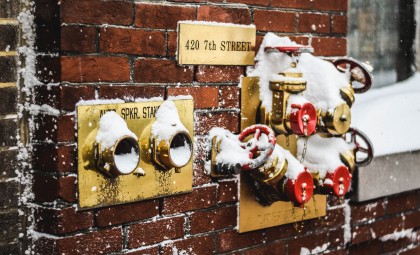Preparing for Winter

Please Note: This article was originally published in October, 2019. All resources and figures showcased below have been updated as of December, 2025.
With a change of seasons comes a change in how we prepare and protect our property. It’s imperative that healthcare organizations have a plan in place to deal with property complications caused by plummeting temperatures and snowy conditions.
Recognizing the importance of preparing subscribers for winter, HIROC partnered with FM to co-host an educational webinar raising awareness of winter hazards. The webinar focused on strategies that avoid or reduce the impact of the season’s most common property claims.
As your trusted healthcare safety advisor, HIROC aims to provide its subscribers with valuable tools and education sessions to help mitigate risk, all with the goal of preventing claims and keeping patients, families and staff safe.
Hosts Jonathan Bracamonte, Director, Brokerage at HIROC, and Alex Holt, Account Engineer at FM, discussed current claims trends and highlighted the range of resources available for HIROC subscribers. Subscribers can access the complete webinar on HIROC.com.
An increase in frequency – what we’re seeing
Water damage is the number one property loss driver for healthcare organizations. During the winter, property claims are typically related to domestic water damage (due to events like frozen pipes), overland flooding, snow loading and drain blockage.
From 2020 to 2025, 64 per cent of all property claims paid by HIROC were related to water damage. In 2025 alone, 74 per cent of claims paid are related to water damage.
The average water damage claim in 2023 was $212,370.16. This is higher compared to the $126,000 average water damage claim in 2018.
The data shows that frequency and severity of water damage claims have increased significantly.
“Wild and inconsistent winters seem to be the new normal,” says Bracamonte. “The hard freezing and thawing in a fast cycle have stressed out our piping infrastructure.”
Freeze-ups
“When it comes to winter conditions, the most common types of losses are related to freeze-ups, and resulting water damage,” says Holt. “During field engineering visits, we spend the most time reviewing this hazard and providing solutions for each facility to mitigate vulnerabilities.”
Freezing temperatures are known to rupture pipes, water tanks, and other appliances. When it comes to building infrastructure, the usual causes of freeze-ups are:
- Inadequate preparation of the site itself and staff responsible for it
- A lack of or inadequate insulation of liquid-containing piping and building envelope
- A lack of continuous monitoring of critical areas or identification of changes to the building or environment
For example, because most healthcare facilities have sprinkler protection systems, they are at risk of piping freeze-up. Stagnant water within sprinkler pipes can freeze if not monitored, as opposed to the continually flowing water in domestic water piping.
Reducing the severity of a burst pipe and water leakage incident relies upon how staff respond in the moments following a pipe rupture. Providing staff in advance with a formal and documented Water Leakage Emergency Response Plan, complete with mock drills and equipment reviews, is critical to risk mitigation.
FM’s Freeze-up Checklist and Sample Water Leakage Emergency Response Plan are excellent resources to help prepare your organization.
Flooding
Flooding is the second most common winter hazard for hospitals. Though they can happen at any time of year, floods typically affect facilities in the spring when there is significant snowmelt and heavy rainfall.
Similar to a water leakage response plan, your organization should also have a Flood Emergency Response Plan (FERP). A healthy policy describes critical responsibilities for staff and includes actions to take before, during, and after flooding to minimize damage. A good plan outlines:
- A means of warning
- Personnel on call for all shifts
- Where response equipment is located within the facility
- What areas are most likely to exposed
- Deployment of any physical protection available
Clean-up and decontamination after a water event can be costly, so it's essential to conduct regular FERP reviews, combined with regular building inspections before a flooding event.
If you’re in need of a particular resource or have questions, contact HIROC’s Jean Asuncion, Senior Account Executive, at [email protected].
By Marc Aiello, Communications and Marketing Specialist, HIROC